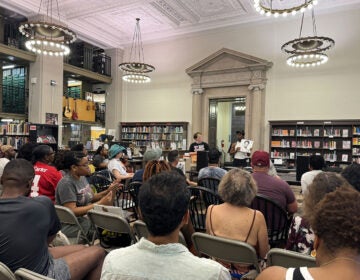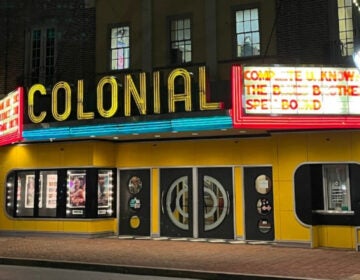Carpet firm looms large in traditional weaving
The long, low building on Route 1 in Langhorne doesn’t look like much when you drive by. But as you walk closer, the rhythmic sounds of heavy iron machinery suggest something enormous is happening inside.
What are they building in there?
The Langhorne Carpet Company is one of the last manufacturers of woven carpets. Most carpet is now made by computerized “tufting” — a row of needles knitting carpets to a backing material and binding them with glue.
The company in Bucks County, however, uses mechanical looms that haven’t changed much since the Industrial Age, when Philadelphia was dubbed “The Workshop of the World.”
Punch machines, counterweights, spinners, yarn racks, shuttles and 30-ton iron looms carefully fold warp into weft. To stand in the middle of the mill is to hear a symphony of industry.
The company was started in the 1930s by John Kommer with his son. Eighty years later, some of those original machines are still on the mill floor, and the family is still in the office. Kommer’s great-grandchildren, Bill Morrow and his sister Winifred, are still turning out carpets of the highest quality.
Their work can be seen in the extravagantly ornate meeting rooms of Philadelphia’s Masonic Temple, in the historic Old Statehouse in Boston, and in the Virginia Statehouse.
The distinction is the weaving, says Bill Morrow. Woven carpets are able to create designs with richer detail than tufted carpets, and the piles can be adjusted to create subtle textures. “It’s not sold by price,” says Morrow. “It’s sold by quality.”
The carpets are woven using techniques that haven’t changed much since the 19th century.
“It’s basically a punch-card system,” says Morrow. “The closest thing is a player piano.”
A rack the size of a delivery van holds more than 3,000 spools of yarn. Each thread is delicately drawn through a tiny hole in a jacquard (a thin wooden slat) punched with the design of that particular carpet, be it floral, paisley or hound’s-tooth.
The Langhorne Carpet Company is sought-after because it can re-create old carpeting when only a few square inches of the original pattern still exist.
Sometimes not even that much. For the Boston Statehouse, they only had a painting of President John Adams standing on the carpet. “It’s detective work,” says Morrow.
Some of the specialty design work is done by Morrow’s mother, Winifred Morrow Sr., 88. She ran the factory in the 1950s when her husband did the selling. After spending most of her life in the carpet business, she still loves it.
“It’s very gratifying when you see a well-woven piece of carpet come out of the finishing room,” she said. “It’s an accomplishment, you feel as though you’ve done something. It’s there, you can hold it in your hand.”
Their carpets can not only be seen at, for example, Tavern on the Green in Central Park, but the sound of the factory has been used, as well. An artist at the Fabric Workshop and Museum in Philadelphia once used the clanking rhythm of their iron looms for an installation piece.
WHYY is your source for fact-based, in-depth journalism and information. As a nonprofit organization, we rely on financial support from readers like you. Please give today.




